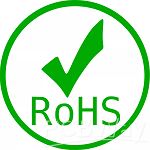RoHS stands for Restriction of Hazardous Substances, and it has had an impact on the entire electronics industry and many electrical products. The original RoHS, also known as Directive 2002/95/EC, was introduced in the European Union in 2002 and restricted the use of six hazardous substances in electronic and electrical products. Since July 1, 2006, all products applicable to the EU market must comply with the requirements of RoHS.
Directive 2011/65/EU, released by the European Union in 2011, is known as RoHS-Recast or RoHS 2. RoHS 2 includes the CE marking directive, which requires products to comply with RoHS requirements when carrying the CE mark. RoHS 2 also added the 8th and 9th categories and introduced additional compliance documentation requirements.
Directive 2015/863 is known as RoHS 3. RoHS 3 added four additional restricted substances (phthalates) to the list of six hazardous substances.

Original 6 substances (2011/65/EU):
Cadmium (Cd): < 100 ppm
Lead (Pb): < 1000 ppm
Mercury (Hg): < 1000 ppm
Hexavalent Chromium: (Cr VI) < 1000 ppm
Polybrominated Biphenyls (PBB): < 1000 ppm
Polybrominated Diphenyl Ethers (PBDE): < 1000 ppm
Newly-added 4 substances-ROHS 3((EU)2015/863):
Bis(2-Ethylhexyl) phthalate (DEHP): < 1000 ppm
Benzyl butyl phthalate (BBP): < 1000 ppm
Dibutyl phthalate (DBP): < 1000 ppm
Diisobutyl phthalate (DIBP): < 1000 ppm
RoHS regulations, also known as the Lead-Free Directive, aim to restrict the environmental pollution caused by toxic electronic waste. Even minimal proportions of the mentioned elements are harmful to plants and animals. They pollute the environment and pose risks of occupational exposure. This standard is closely related to the Waste Electrical and Electronic Equipment (WEEE) Directive in the European Union. While RoHS controls the use of hazardous chemicals, WEEE monitors the disposal of these products. Non-compliance with RoHS regulations can cause significant harm to a company's operations and impact profitability. Here are the benefits of replacing lead-based solder with lead-free alternatives:
Environmental Protection: Reducing or eliminating lead in PCBs helps prevent lead pollution in soil, air, and water sources, thus protecting wildlife and public health. Additionally, lead-free PCBs are easier to safely recycle, contributing to minimizing electronic waste and ensuring an adequate supply of scarce electronic resources.
Worker Health Protection: Prolonged or short-term exposure to lead can cause various negative health effects, ranging from headaches to decreased fertility. Manufacturing products that comply with RoHS regulations helps protect workers involved in assembly and recycling of PCBs, as well as children and other vulnerable populations living in proximity.
Market Access: Selling products that do not comply with RoHS requirements is prohibited in all member states of the European Union and California. Manufacturing lead-free products enables you to sell in these lucrative markets.
RoHS does not directly impact the quality of PCBs. Simply complying with RoHS does not necessarily improve the quality of the circuit board. However, RoHS, or more commonly known as "lead-free," does have significant implications for PCB manufacturing and soldering processes. The need to solder circuit boards at higher temperatures requires modifications to the PCB manufacturing process. Newer FR-4 materials have been developed to withstand higher temperatures without compromising the lifespan of the final product.
Downlaod PCBWay PCB RoHS Report 2023: https://www.pcbway.com/img/images/product/RoHS-Report-PCBWay.zip